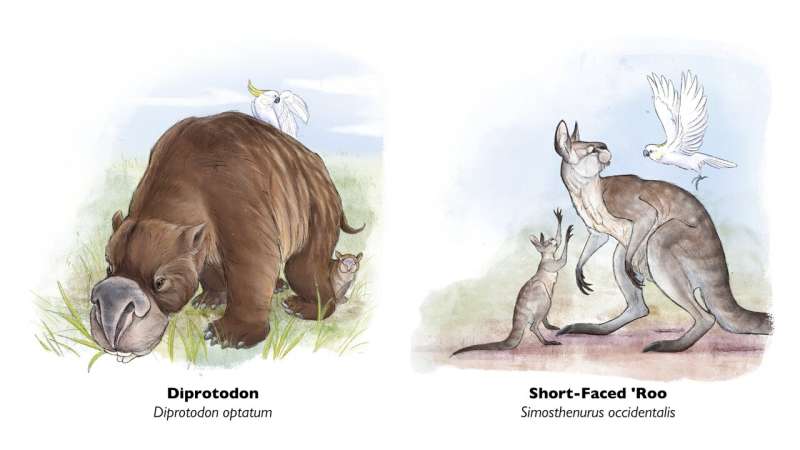Extinct megafauna prone to ancient 'hunger games'

Different combinations of human hunting and climate change caused Australia's famed 'giant' species to go extinct, and now it turns out that for some species, changing food availability made things worse.
Sophisticated new modeling has uncovered a previously unrecognized process contributing to the disappearance of ancient megafauna communities across south-eastern Australia tens of thousands of years ago—and for the huge herbivores, it comes down to dinner.
Complex ecological network models developed by Australian and international researchers reveal how the big, plant-eating megafauna of the Naracoorte region in the southeast of modern-day South Australia were vulnerable to changes in the plants on which they fed. Changing food supply driven by climatic changes or human land use in the Late Pleistocene era might have facilitated the extinction of the biggest herbivores.
The research was led by scientists at the Australian Research Council Center of Excellence for Australian Biodiversity and Heritage (CABAH) at Flinders University. The modeling methods and analysis are reported in a paper in the scientific journal Ecography.
The Naracoorte Caves World Heritage area is well-known for its ancient megafauna fossils. However, while we know that animals such as the giant, wombat-like plant eaters Diprotodon roamed Australia and eventually went extinct, the combination of events leading to their extinction varies across the continent. The particular blend of environmental changes and human hunting responsible in any given region is therefore still debated.
To shed some ecological light on the problem, a team of ecologists, computer modelers and paleontologists from five universities used sophisticated mathematical techniques to build computer-based networks that represented the Naracoorte ecosystem—from plants to invertebrates, plant-eaters, and the carnivores that ate them—to investigate why certain species eventually died off, and others survived.
After determining how changes in the plant community might cascade up through the network to affect the biggest herbivores, the scientists then built versions of the Naracoorte community network to test whether the megafauna were more vulnerable to extinction cascades that started with the plants, and whether the now-extinct megafauna species occupied differed positions in the network compared to species that survived to the modern era.
"By modeling the ecological community using powerful computing methods, we can simulate any extinct or modern species' relative position in the overall food chain as it existed many millennia ago, and then estimate how vulnerable these species were to changes in the ecosystem," says Flinders University evolutionary ecologist and lead author Dr. John Llewelyn.
"Our models revealed that extinct species of megafauna, particularly the big plant eaters, were more vulnerable to these 'bottom-up' coextinction cascades triggered by changes in plant species than were the species that we still have around today."
The analyses also showed that species lower on the food chain, such as plant eaters that specialized on only a few plant species for food, were particularly vulnerable.
CABAH Chief Investigator and Models Theme Leader Professor Corey Bradshaw from Flinders University says that despite decades of research trying to understand what caused Australia's biggest species to die out, much of the ecology of these communities has been overlooked.
"Ecological-network models are valuable tools for studying interactions among species and examining how past extinction events unfolded, as well as how future extinction patterns might play out.
"Our methods have evolved impressively over the past few years to be able to infer not only who probably ate whom in these long-disappeared communities, but also provide fresh ecological insights into how extinction cascades likely occurred using the power of modern computing," says Professor Bradshaw.
"Like most ecological events, the underlying reasons for big changes observed in the past, and those predicted in the future, are complex and rarely turn out to be caused by single disturbances. The disappearance of many of Australia's largest animals is no different in this regard."
Dr. Llewelyn says network modeling is a holistic approach to predict interactions among species and the impact of environmental changes across a community. However, the technique is underutilized despite its potential.
"We hope more researchers will start to realize the value of ecological networks for predicting ecological changes. It's an emerging area that has a lot of potential," Dr. Llewelyn says.
More information: John Llewelyn et al, Sahul's megafauna were vulnerable to plant‐community changes due to their position in the trophic network, Ecography (2021). DOI: 10.1111/ecog.06089
Journal information: Ecography
Provided by Flinders University




















